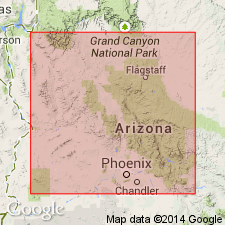
- Usage in publication:
-
- Boriana granodiorite
- Modifications:
-
- Named
- Dominant lithology:
-
- Granodiorite
- AAPG geologic province:
-
- Plateau sedimentary province
Summary:
[Probably named for Boriana Canyon, 34 deg 53' 47"N, 113 deg 57' 01"W, Wabayuma Peak 7.5' quad, Mohave Co, AZ] Name is used to distinguish rock unit in trace element study, though name as used herein "has no claim to priority". Boriana pluton perhaps of batholithic dimensions underlies major part of Hualapai Mountains, northwestern AZ. Main facies of Boriana granodiorite is medium- to coarse-grained biotite granodiorite. Locally texture is somewhat porphyritic with zoned plagioclase grains in finer-grained matrix of intergrown plagioclase, quartz, microcline, and biotite. Is part of Cerbat complex. Pluton not observed in contact with Hualpai granite (new) (of Cerbat complex) but believed to bear intrusive relationship to Wikieup granite (new) (of Cerbat complex). Entire Hualpai [now Hualapai] Range has been mapped by Schrader (1909) as Precambrian complex, but lack of sedimentary rocks and intrusive nature of Boriana pluton make age designation difficult. It is entirely possible Boriana granodiorite is much younger, possibly Mesozoic in age.
Source: GNU records (USGS DDS-6; Menlo GNULEX).
For more information, please contact Nancy Stamm, Geologic Names Committee Secretary.
Asterisk (*) indicates published by U.S. Geological Survey authors.
"No current usage" (†) implies that a name has been abandoned or has fallen into disuse. Former usage and, if known, replacement name given in parentheses ( ).
Slash (/) indicates name conflicts with nomenclatural guidelines (CSN, 1933; ACSN, 1961, 1970; NACSN, 1983, 2005, 2021). May be explained within brackets ([ ]).

